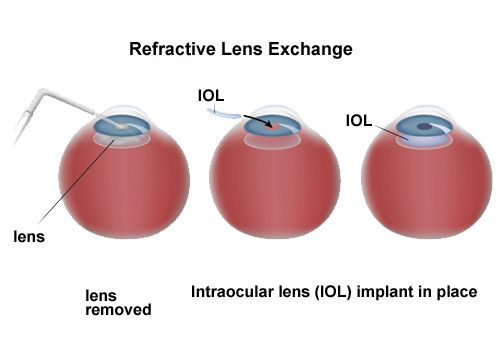Refractive Lens Exchange (RLE) is a surgical procedure that involves removing the natural lens of the eye and replacing it with an artificial intraocular lens (IOL) to correct refractive errors such as nearsightedness, farsightedness, and astigmatism. This procedure is commonly used to treat patients over 50 years old who have developed presbyopia, a condition that causes difficulty in focusing on close objects. RLE is also used to treat cataracts, a condition in which the lens of the eye becomes cloudy and impairs vision.
RLE Procedure
The RLE procedure is performed under local anesthesia and takes approximately 15-30 minutes per eye. A small incision is made on the side of the cornea, and the natural lens is removed using a technique called phacoemulsification, which involves breaking up the lens into small pieces and removing it with a suction device. The artificial IOL is then implanted into the eye through the same incision. The incision is so small that no stitches are required, and the eye typically heals quickly without any discomfort.
RLE Cost
The cost of RLE can vary depending on several factors such as the location, the surgeon’s experience, the type of IOL used, and any additional procedures that may be required. On average, the cost of RLE ranges from $3,000 to $6,000 per eye. It is important to note that most insurance companies do not cover the cost of RLE as it is considered a cosmetic procedure.
RLE Pros and Cons
Pros:
- Permanent Solution: RLE is a permanent solution to refractive errors and presbyopia. Once the natural lens is removed and replaced with an artificial IOL, the patient’s vision is corrected, and there is no need for glasses or contact lenses.
- Improved Quality of Life: RLE can improve the quality of life for patients who have difficulty performing daily activities due to poor vision. Patients can enjoy clear vision and the ability to read, drive, and participate in activities without the need for glasses or contact lenses.
- Low Risk: RLE is a safe and low-risk procedure. Complications are rare, and most patients experience a quick and painless recovery.
Cons:
- Cost: The cost of RLE can be a barrier for many patients, as it is not covered by most insurance companies.
- Risks: Although rare, there are risks associated with any surgical procedure. Complications such as infection, bleeding, and vision loss can occur.
- Not Reversible: Once the natural lens is removed and replaced with an artificial IOL, the procedure cannot be reversed. If the patient is not satisfied with the results, there is no going back.
RLE Surgery
RLE surgery is a safe and effective way to correct refractive errors and presbyopia. It is important to discuss the procedure with your doctor and weigh the pros and cons before making a decision. With the right surgeon and the proper preparation, RLE can provide a permanent solution to poor vision and improve the quality of life for many patients.
In conclusion, Refractive Lens Exchange (RLE) is a safe and effective surgical procedure for patients looking to correct their vision and reduce their dependence on glasses or contact lenses. With the use of advanced technology and skilled surgeons, RLE offers a permanent solution to refractive errors and presbyopia, improving patients’ quality of life. However, like any medical procedure, RLE has its pros and cons. While the benefits of RLE are numerous, patients should also be aware of the risks involved and the potential need for additional procedures in the future. The cost of RLE can also be a significant investment, but for many patients, it is worth the investment. It is important to consult with a qualified and experienced surgeon to determine if RLE is the right choice for you based on your unique needs and circumstances.
